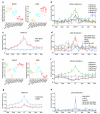DNA hypomethylation within specific transposable element families associates with tissue-specific enhancer landscape
- PMID: 23708189
- PMCID: PMC3695047
- DOI: 10.1038/ng.2649
DNA hypomethylation within specific transposable element families associates with tissue-specific enhancer landscape
Abstract
Transposable element (TE)-derived sequences comprise half of the human genome and DNA methylome and are presumed to be densely methylated and inactive. Examination of genome-wide DNA methylation status within 928 TE subfamilies in human embryonic and adult tissues identified unexpected tissue-specific and subfamily-specific hypomethylation signatures. Genes proximal to tissue-specific hypomethylated TE sequences were enriched for functions important for the relevant tissue type, and their expression correlated strongly with hypomethylation within the TEs. When hypomethylated, these TE sequences gained tissue-specific enhancer marks, including monomethylation of histone H3 at lysine 4 (H3K4me1) and occupancy by p300, and a majority exhibited enhancer activity in reporter gene assays. Many such TEs also harbored binding sites for transcription factors that are important for tissue-specific functions and showed evidence of evolutionary selection. These data suggest that sequences derived from TEs may be responsible for wiring tissue type-specific regulatory networks and may have acquired tissue-specific epigenetic regulation.
Figures




Comment in
-
Hypomethylation marks enhancers within transposable elements.Nat Genet. 2013 Jul;45(7):717-8. doi: 10.1038/ng.2680. Nat Genet. 2013. PMID: 23800863
References
-
- Lander ES, et al. Initial sequencing and analysis of the human genome. Nature. 2001;409:860–921. - PubMed
-
- Kunarso G, et al. Transposable elements have rewired the core regulatory network of human embryonic stem cells. Nature Genetics. 2010;42:631–4. Epub 2010 Jun 6. - PubMed
-
- Lynch VJ, Leclerc RD, May G, Wagner GP. Transposon-mediated rewiring of gene regulatory networks contributed to the evolution of pregnancy in mammals. Nat Genet. 2011;43:1154–9. - PubMed
Publication types
MeSH terms
Substances
Grants and funding
- 5U01ES017154/ES/NIEHS NIH HHS/United States
- U01 ES017154/ES/NIEHS NIH HHS/United States
- P01 CA095616/CA/NCI NIH HHS/United States
- P01 CA142536/CA/NCI NIH HHS/United States
- P01CA142536/CA/NCI NIH HHS/United States
- P01CA095616/CA/NCI NIH HHS/United States
- P50 CA134254/CA/NCI NIH HHS/United States
- T32 GM081739/GM/NIGMS NIH HHS/United States
- R25 DA027995/DA/NIDA NIH HHS/United States
- R01 HG007354/HG/NHGRI NIH HHS/United States
- HHMI/Howard Hughes Medical Institute/United States
- P50CA134254/CA/NCI NIH HHS/United States
LinkOut - more resources
Full Text Sources
Other Literature Sources
Molecular Biology Databases
Miscellaneous

